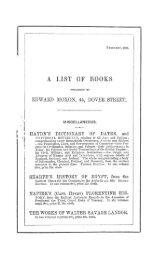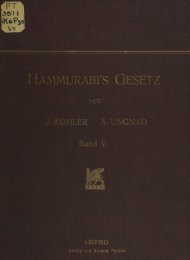•-***!:* :li2H jIEÜ~ 1 1 1 - JScholarship
•-***!:* :li2H jIEÜ~ 1 1 1 - JScholarship
•-***!:* :li2H jIEÜ~ 1 1 1 - JScholarship
Sie wollen auch ein ePaper? Erhöhen Sie die Reichweite Ihrer Titel.
YUMPU macht aus Druck-PDFs automatisch weboptimierte ePaper, die Google liebt.
250 On the philosophy of the Vedänta.<br />
expiation, first in heaven and hell, and then again in a new existence<br />
on the earth. This double expiation is different (1) for performers of<br />
good works, going the pitriyäna, (2) for worshippers of the sagunam<br />
brahma, going the devayäna, (3) for wicked deeds, leading to what is<br />
obscurely hinted at in the Upanishads as the trittyam sthänam, the third<br />
place. (1) The pitriyäna leads through a succession of dark spheres to<br />
the moon, there to enjoy the fruit of the good works and, after their<br />
consumption, back to an earthly existence. (2) The devayäna leads<br />
through a set of brighter spheres to Brahman, without returning to the<br />
earth (teshäm na punar ävrittih). But this Brahman is only sagunam<br />
brahma, the object of worshipping, and its true worshippers, though<br />
entering into this sagunam brahma without returning, have to wait in it<br />
until they get moksha by obtaining samyagdarganam, the füll knowledge<br />
of the nirgunam brahma. (3) The trittyam sthänam, including the later<br />
theories of hells, teaches punishment in them, and again punishment<br />
by returning to earth in the form of lower castes, animals, and plants.<br />
All these various and fantastical ways of Samsära are considered as true,<br />
quite as true as this world is, but not more. For the whole world and<br />
the whole way of Samsära is valid and true for those only who are in<br />
the avidyä, not for those who have overcome her, as we have to show<br />
now.<br />
The esoteric Vedänta does not admit the reality of the world nor<br />
of the Samsära, for the only reality is Brahman, seized in ourselves as<br />
our own Ätman. The knowledge of this Ätman, the great intelligence:<br />
"aham brahma asmi," does not produce moksha (deliverance), but is<br />
moksha itself. Then we obtain what the Upanishads say:<br />
bhidyate hridaya-granthih,<br />
chidyante sarva-samgayäh,<br />
kshtyante cäsya karmäni,<br />
tasmin drishte parävare.<br />
"When seeing Brahma as the highest and the lowest everywhere, all<br />
knots of our heart, all sorrows are split, all doubts vanish, and our works<br />
become nothing." Certainly no man can live without doing works, and<br />
so also the Jivanmukta; but he knows it, that all these works are illusive,<br />
as this whole world is, and therefore they do not adhere to him nor<br />
produce for him a new life after death.—And what kind of works may<br />
such a man do ?—People have öften reproached the Vedänta with being<br />
defective in morals, and indeed, the Indian genius is too contemplative<br />
to speak much of works; but the fact is nevertheless, that the highest<br />
and purest morality is the immediate consequence of the Vedänta. The<br />
Gospels fix quite correctly as the highest law of morality: "love your<br />
neighbour as yourselves." But why should I do so, since by the order

















